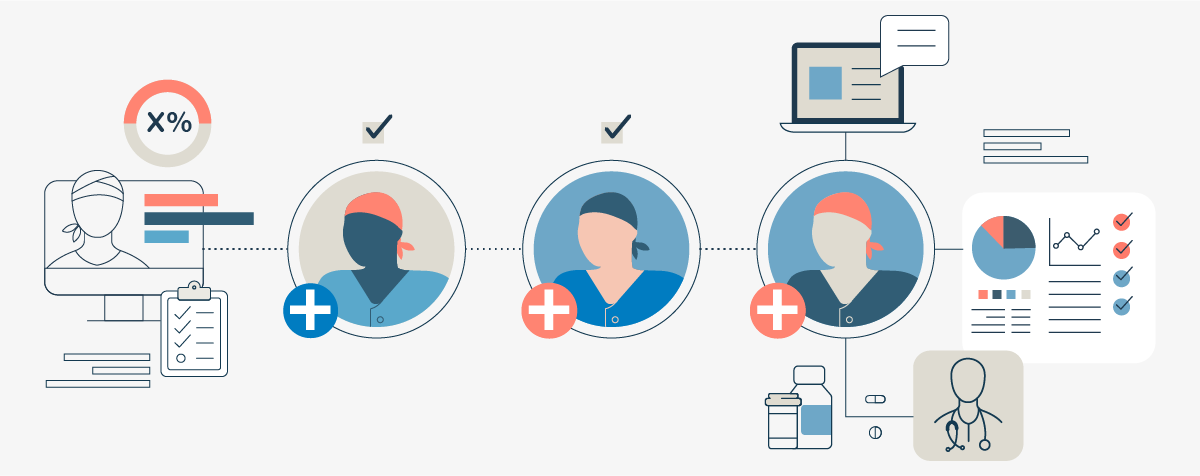
Real-world evidence (RWE) continues to increase in importance for the development of new drugs and treatment strategies in oncology. Offering insight into how a drug performs in real clinical settings, RWE can help provide a more comprehensive view of patient response, better understanding of disease patterns and better safety information.
RWE is generated from real-world data (RWD), or information about either patient health status or the delivery of healthcare that is routinely collected from a variety of sources, including electronic health records (EHR), billing and claims databases and disease registries.
EHRs are the most common source of RWD, but they may not always present the entire picture. That is where a data source like healthcare claims comes in. Claims data provide detail on care events on a specific date and site of care, such as doctor visits and any prescriptions, lab tests, or procedures ordered. Information in healthcare claims is not limited by what is entered into an EHR.
When paired together, EHR and claims data provide a comprehensive view into the patient journey that enhances the ability for both RWD and RWE to impact care.
The growing importance of RWD and RWE
The growing adoption of RWE in the regulatory process presents an exciting opportunity to re-think how we use data in oncology. To fully understand the cancer treatment journey, it is critical to identify both primary characteristics (e.g., disease staging, biomarkers, treatment) as well as related elements that impact outcomes (e.g., medication adherence, comorbidities, contraindications to treatment). This holistic view, built from information across EHR and reimbursement systems, is essential for credibly supporting regulatory decision-making.
Ontada’s iKnowMedSM oncology EHR, which captures outpatient medical histories from community oncology practices treating more than 1 million patients per year, has successfully been used to help life sciences companies understand the real-world utilization and outcomes associated with a number of oncology agents. A real-world retrospective analysis in metastatic Merkel cell carcinoma1, which helped support the first FDA approval for first-line therapy in this population, is an excellent example of how EHR data provided essential information about treatment responses and patient outcomes.
The power in pairing EHR and claims data
While claims provide important information, they are not intended to represent clinical outcomes. Using claims data can be like looking at someone's credit card bill - you know where they shopped, but maybe not exactly what was bought. For example, a medical claim can indicate a patient underwent a laboratory test, but only the EHR will contain the result. On the other hand, a patient may get tests ordered by multiple providers, and using only one EHR for testing data may mean missing critical elements of a patient’s health status.
Medication adherence is an example of how claims data can address gaps in EHR data. From an RWE perspective, we might seek to understand why some patients are responding poorly to an oral medication compared to others – and one of the reasons might be their adherence to the medication. It is common to see evidence that a doctor has prescribed an oral medication in the EHR, but it is claims data that can identify the extent to which a patient receives that medication from a pharmacy.
The integration of claims and EHR data, both sources of RWD, provide a more holistic view of the patient journey. Their strengths and weaknesses are complementary, and in tandem they hold the promise of delivering more complete RWD and RWE for larger populations of cancer patients across longer time periods, and that can span multiple doctors, diagnoses, insurers, and EHRs.
Better data leads to better care
The role of RWE in drug development and regulatory approval is dependent on high quality data2. The synthesis of claims data with clinical evidence from the EHR is one way to improve quality by building a more complete understanding of treatment utilization and effectiveness. Continuing to develop methodologies for combining disparate data sources helps to advance the treatment landscape.
1https://pubmed.ncbi.nlm.nih.gov/28605939/
2 Charles, M. & Chandrasekaran, V. Data Stewardship | The privilege and responsibility of ensuring data quality and methodological rigor. Ontada. Retrieved from https://lifesciencescontent.mckesson.com/Ontada.WhitePaper.EVRGRN.DataStewardship_LandingPage1.html



